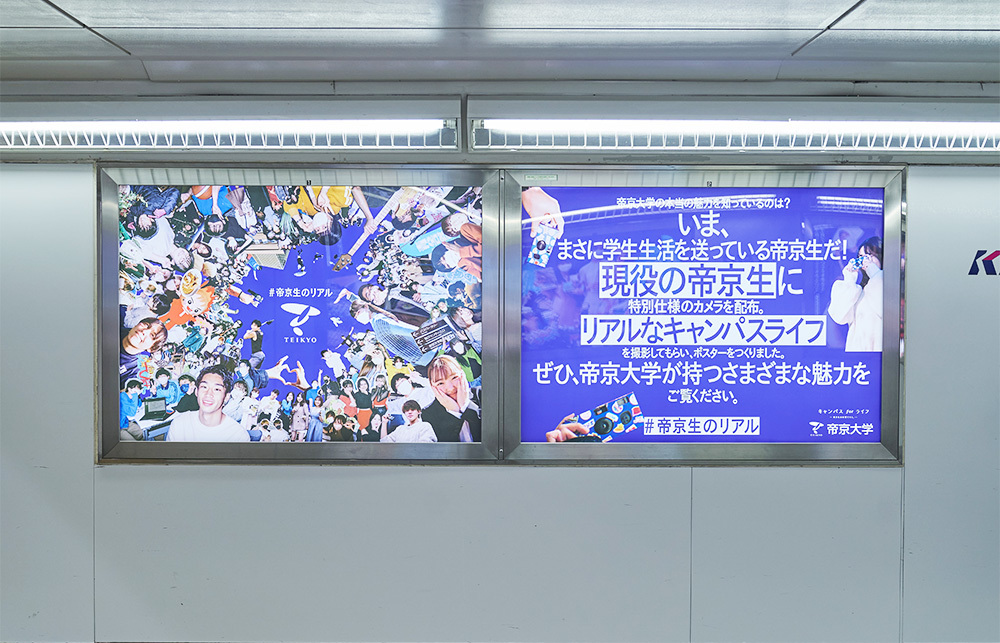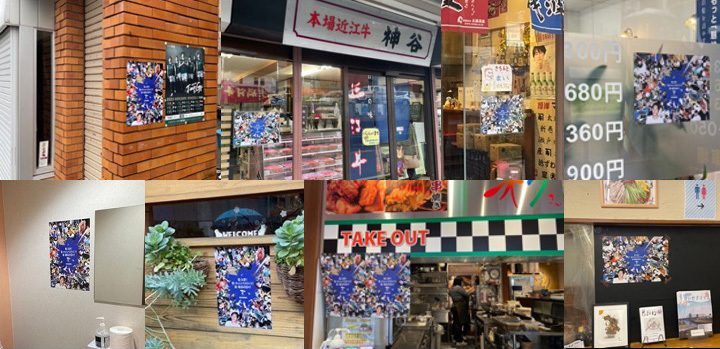How can Dentsu Inc.'s creative team contribute to the ever-evolving field of CX (Customer Experience)? "Monthly CX" is a series where members of Dentsu Inc.'s CX specialist division, the "CXCC" (Customer Experience Creative Center), share insights ( For more on Monthly CX, click here ).
This time, we introduce Teikyo University's promotional campaign, " #TeikyoStudentsReal." All the photos used in the creative were taken by current students using specially designed cameras. Why use photos taken by students instead of professionals? Why use cameras instead of the more convenient smartphones? We spoke with Fumi Anaura, who worked on this project, about the campaign's objectives and the behind-the-scenes story of the creative production.

[Fumi Anaura Profile]
Dentsu Inc.
Customer Experience Creative Center
Art Director
Born in Fukuoka Prefecture. Graduated from Kanazawa College of Art. Handles art direction projects that transcend boundaries, including advertising that integrates mass media and digital, and exhibition planning and activation strategies linked to purpose branding.
Awards include Spikes Asia/Digital Craft Grand Prix, ADFEST Gold, Good Design Award, ACC Award, and selection for the Japan Package Design Awards.
Current students shoot with special-spec cameras! Guiding ads showcase the real daily lives of Teikyo students
Monthly CX: What exactly was the "#TeikyoStudentsReal" initiative?
Anaura: It was a promotional initiative where we created posters and videos conveying Teikyo University's appeal using photos taken by current students with specially designed cameras.

A specially customized camera with a lens cover designed for "#TheRealTeikyoLife"

Key visual for "#TheRealTeikyoLife"
Ainura: The idea came to me when I looked at typical university prospectus materials and felt the photos used were too uniform and overly polished. They seemed to show "the ideal university life as envisioned by adults," lacking any sense of the university's unique character.
That's when I thought of having current students take the photos. By having actual Teikyo University students capture the images, I believed we could convey unvarnished, real information to prospective students.
Monthly CX: I see. How were the photos used in the ads selected?
Anaura: The main selection was done by three of us: myself, the designer, and another art director. We also enlisted help from other members to ensure multiple perspectives were considered in the selection process.
Furthermore, since we handled the photo development here, the current students didn't see what photos they had submitted. To build excitement for this initiative, we also made efforts like publishing the collected photos on a teaser site before the ad production began.
Monthly CX: So you also implemented measures to boost the students' enthusiasm. Looking at the final creative work, I feel the collages—rather than single photos—really enhance the emotional impact.
Anaura: Thank you. We created a total of 16 types of advertising creatives, including the key visuals.
These were deployed as OOH displays within stations and also posted at the Hachioji Campus and in shopping districts near the university. They were also utilized for open campus event promotions.
Monthly CX: I understand videos were also produced for this initiative.
Anaura: Yes. The videos were distributed through advertisements on a BS program sponsored by Teikyo University and YouTube ads.
Campus Life: Voices of Students [Teikyo University TVCM]
Another key point was our foray into digital advertising. Teikyo University hadn't actively pursued digital ads before. However, since the target audience this time was high school students, we proposed to the client that "it would be a waste not to leverage digital." That's why we decided to challenge ourselves with digital ad distribution on YouTube and TikTok.
The sentiment behind the message "We welcome students who haven't found their passion"
Monthly CX: The message in the video and ads—"Teikyo University welcomes students who haven't found their passion"—really stood out to me. What was the intention behind creating this?

A frame from the video distributed on YouTube
Ainura: You often hear the phrase "Do what you want to do," right? But I thought that for students who haven't found what they want to do yet, that prevailing sentiment might actually feel like a burden. I wanted to send a message specifically to those students.
Teikyo University offers a wide range of faculties and departments. While some students enter knowing what they want to do, others don't. But we believe that through their student life here, everyone will find their passion. This phrase was born from the belief that this possibility could be a source of comfort for students.
Monthly CX: The blue background is impactful, and the design framing the current students' photos is also striking. What thoughts went into this design?

Advertisement displayed at Shinjuku Station
Anaura: Blue is Teikyo University's school color. This design was created to express Teikyo's characteristic of "all students being the protagonists" creatively, rather than focusing on one student as a hero.
The camera is a special device to boost participation enthusiasm
Monthly CX: How did current students react when asked to take photos?
Anura: They participated more actively than we anticipated. We planned to distribute the cameras over two days, but we actually finished distributing them all in just one day! We were a bit anxious about how many of the 300 cameras we prepared would actually be taken, so hearing they were all distributed was a huge relief.
The campus newspaper even featured this initiative. It shared a student's comment: "At first, I felt a bit shy and walked past the distribution spot, but I thought this might be a chance to create some memories, so I took a camera." That made me very happy.
Other comments included, "I want people to see how emotional our everyday lives can be," and "Even though I've been here three years, I want to discover things I didn't know." I was worried people might think, "Taking photos is such a hassle," but that turned out to be an unfounded worry.
Monthly CX: The Y2K (2000s) trend might have also helped, as the film cameras with lenses we used this time are recognized by the younger generation. Still, I'm curious about the intention behind deliberately having the SNS generation, who are used to smartphone photography, shoot with such analog cameras.
Anaura: For initiatives like this, I believe you need a special device to boost participants' excitement, and in this case, that was the camera. Campaigns where you take photos with your smartphone and post them on SNS are common, and I think they're great because they're easy to do. But if I were a student, I don't think my motivation to post would be that high. We deliberately chose the lens-equipped film to create that sense of something special.
Monthly CX: I imagine the thrill of not knowing what the photos would look like until they were developed felt like an event to the students and was enjoyable.
Ainoura: I'm glad they felt that way.
Personally, I find lens-equipped film appealing not just for the fun of shooting, but also because it produces photos with that unique, grainy texture only film can give. When I actually saw the developed photos, I felt they captured a raw quality different from high-resolution smartphone photos.
Even when people were smiling, the photos might be too dark overall due to insufficient light, or the focus might be soft, or they might be blurry. Things that would be immediately rejected in standard advertising photography actually have a unique charm that comes from using lens-mounted film, so we deliberately selected them for this campaign.
The underlying theme of this initiative involving students, staff, and community members is to foster love for their alma mater.
Monthly CX: How many photos were collected?
Anaura: Over 1,500! Coming from a smaller art university, I've always admired the everyday life unique to comprehensive universities. Seeing the developed photos made me think, "I'm jealous!" (laughs). Selecting them was really fun.
It was also interesting discovering how perspectives varied by photographer. For example, in the cafeteria, there were photos of people eating, friends, dishes, empty plates, and staff serving. Even for club-related photos, there were shots focusing on equipment or during matches. Having many photographers allowed us to capture the reality of student life from diverse viewpoints.
Since film with a lens has a limited number of shots, I think participating also gave the students a chance to rediscover the charm of their daily lives through the act of choosing what to photograph.
Monthly CX: Were there any trends, like lots of photos with friends or many selfies?
Anaura: There were more photos of friends than selfies. Friends symbolize university life, right? There were periods during the pandemic when commuting was restricted, and I wondered if students' perspectives on campus life had changed. But the photos conveyed that they valued "going to school" and "meeting friends" itself.
Monthly CX: Could you also share the response after the ads were published?
Anaura: For the digital ads targeting prospective students, we achieved high numbers in metrics like click-through rates.
While prospective students were the main target for this campaign, an underlying theme was also to "strengthen the love and attachment to Teikyo University among students, staff, and local residents." We were conscious of this because it's important for current students to enjoy their four years here. After the ads started running, some students took photos of the posters and shared them on social media, saying things like, "Our club is in the ad!" They seemed genuinely happy that their photos were used.
Monthly CX: I see. How did local residents react?
Anaura: When we approached the shopping district to ask if they would display messages congratulating new students and Open Campus posters, they were more than willing to help—far more than we expected. Some even asked, "Don't you have a larger size?" The welcoming atmosphere was palpable, and it made us very happy.
Monthly CX: So you're building good relationships with stakeholders outside the university too. Will there be a second phase of this initiative?
Anaura: We've decided to continue it next year, and we've already started the second photo project this fall. While the first one was only for current students, the second one expands to include more people connected to the university, such as staff and the campus newspaper club. I'm really looking forward to seeing what photos come in.
CX Creative: Creating Active Fans
Monthly CX: What strengths of yours do you think were particularly valuable for this project?
Anoura: I was able to leverage both my experience as an art director focused on mass advertising and my experience on secondment at Dentsu Digital Inc. Particularly useful were my experiences at Dentsu Digital Inc., where I considered which media channels to use for each funnel stage and expanded the output field beyond specific media. I think this experience helped in creating visuals with students and expanding the scope beyond the campus to the local community.
Monthly CX: What does CX creative mean to you?
Anaura: If conventional advertising aims for awareness, my answer is that CX creative sparks emotions like "I love this" or "I want to recommend this," creating active fans. The approaches to building fans are diverse, and I believe CX creative is the optimal solution for each project.
In this project, traditional school brochures presented how the university "wanted to be seen." But we questioned whether that was truly authentic. That led to a student-participation project. Expressing Teikyo University's unique character through photography fostered school spirit among current students and local residents. That, I believe, was CX creative.
Monthly CX: What new challenges are you looking to take on next?
Anaura: I want to create a positive vortex that inspires everyone involved, not just in advertising. I'm drawn to work that generates compelling stories people want to participate in. If a project can spark positive attitude shifts in participants, I feel the time invested was worthwhile.
Lately, I've been working on projects beyond corporate advertising and branding. These include initiatives that simultaneously solve two distinct challenges, or collaborative product development that applies technology to create experiences previously unattainable. It's work closer to product development. While it feels different from advertising work and presents its own challenges, I find it deeply rewarding.
My job title is Art Director, but I want to do more than just direct—I want to think too. So, everyone, please feel free to reach out!
(Editor's Note)
This time, we introduced Teikyo University's promotional campaign "#TeikyoStudentsReal," which utilizes photos taken by current students with a special camera.
I remember seeing the actual OOH ads and thinking, "It looks lively and fun," but hearing that the photos were taken by Teikyo University students themselves made me realize anew, "That's why it felt so authentic."
This campaign, which naturally appeals to prospective students while also fostering current students' school spirit, is a prime example of the CX creative approach Mr. Anaura strives to achieve.
This interview was conducted in collaboration with 'CX Creative Studio note' ( see here for details on CX Creative Studio note ). We are also working with Dentsu Digital Inc.'s CX Creative team, not just the Dentsu CXCC team, to collect and introduce a wider range of case studies. If you're interested, please check that out as well.
If you have requests for future case studies or topics you'd like us to cover, please send a message to the Monthly CX Editorial Department via the contact page below. Thank you for your continued readership.

Monthly CX Editorial Department
Dentsu Inc. CXCC: Koike, Oda, Otani, Kibata, Takakusagi, Kanasaka, Okumura
















